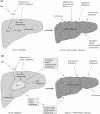Pathogenesis of non-alcoholic fatty liver disease - PubMed (original) (raw)
Review
Pathogenesis of non-alcoholic fatty liver disease
J K Dowman et al. QJM. 2010 Feb.
No abstract available
Figures
Figure 1.
(a) The traditional 2-hit hypothesis: steatosis represents the ‘first hit’, which then sensitises the liver to injury mediated by ‘second hits’, such as inflammatory cytokines, adipokines, oxidative stress and mitochondrial dysfunction, leading to steatohepatitis and fibrosis. The presence of high levels of oxidative stress reduces the ability of mature hepatocytes to proliferate, resulting in reduced endogenous liver repair. (b) Modified 2-hit hypothesis: the accumulation of FFA alone has been suggested to be sufficient to induce liver damage, without recourse for a second hit. Indeed, rather than being harmful, triglyceride accumulation in the form of steatosis may actually be protective by preventing FFA-induced inflammation and oxidative stress. (c) The 3-hit hypothesis: oxidative stress reduces the ability of mature hepatocytes to proliferate, resulting in the recruitment of other pathways of liver regeneration, such as HPCs. These cells have the capability of differentiating into both cholangiocytes and hepatocytes and contributing to liver repair. It has been suggested that an inability to mount such a ductular response, as is seen in patients transplanted for NASH who have denervated livers, may be responsible for a more progressive pattern of liver damage. Thus, impaired proliferation of hepatocyte progenitors represents the proposed ‘third hit’ in NAFLD pathogenesis.
Figure 1.
(a) The traditional 2-hit hypothesis: steatosis represents the ‘first hit’, which then sensitises the liver to injury mediated by ‘second hits’, such as inflammatory cytokines, adipokines, oxidative stress and mitochondrial dysfunction, leading to steatohepatitis and fibrosis. The presence of high levels of oxidative stress reduces the ability of mature hepatocytes to proliferate, resulting in reduced endogenous liver repair. (b) Modified 2-hit hypothesis: the accumulation of FFA alone has been suggested to be sufficient to induce liver damage, without recourse for a second hit. Indeed, rather than being harmful, triglyceride accumulation in the form of steatosis may actually be protective by preventing FFA-induced inflammation and oxidative stress. (c) The 3-hit hypothesis: oxidative stress reduces the ability of mature hepatocytes to proliferate, resulting in the recruitment of other pathways of liver regeneration, such as HPCs. These cells have the capability of differentiating into both cholangiocytes and hepatocytes and contributing to liver repair. It has been suggested that an inability to mount such a ductular response, as is seen in patients transplanted for NASH who have denervated livers, may be responsible for a more progressive pattern of liver damage. Thus, impaired proliferation of hepatocyte progenitors represents the proposed ‘third hit’ in NAFLD pathogenesis.
Figure 2.
Mechanisms of hepatic fat accumulation.
Figure 3.
Proposed pathogenesis of NASH. The likelihood of progression to advanced NASH/cirrhosis results from a complex interplay between genetic predisposition and the mechanisms described earlier.
Comment in
- QJM. 2010 Feb;103(2):69-70
Similar articles
- New concepts in the pathogenesis of alcoholic liver disease.
Albano E. Albano E. Expert Rev Gastroenterol Hepatol. 2008 Dec;2(6):749-59. doi: 10.1586/17474124.2.6.749. Expert Rev Gastroenterol Hepatol. 2008. PMID: 19090736 Review. - [Fatty liver and its clinical management in obese adolescents].
González Jiménez E, Schmidt Río-Valle J, Álvarez Ferre J. González Jiménez E, et al. Endocrinol Nutr. 2011 Jan;58(1):32-7. doi: 10.1016/j.endonu.2010.10.005. Epub 2011 Jan 7. Endocrinol Nutr. 2011. PMID: 21216209 Review. Spanish. - Non-alcoholic steatohepatitis and metabolic syndrome.
Machado M, Cortez-Pinto H. Machado M, et al. Curr Opin Clin Nutr Metab Care. 2006 Sep;9(5):637-42. doi: 10.1097/01.mco.0000241677.40170.17. Curr Opin Clin Nutr Metab Care. 2006. PMID: 16912563 Review. - Non-alcoholic steatohepatitis: pathogenesis and novel therapeutic approaches.
Schuppan D, Schattenberg JM. Schuppan D, et al. J Gastroenterol Hepatol. 2013 Aug;28 Suppl 1:68-76. doi: 10.1111/jgh.12212. J Gastroenterol Hepatol. 2013. PMID: 23855299 Review. - Review article: the pathogenesis of fibrosis in non-alcoholic steatohepatitis.
Marra F, Aleffi S, Bertolani C, Petrai I, Vizzutti F. Marra F, et al. Aliment Pharmacol Ther. 2005 Nov;22 Suppl 2:44-7. doi: 10.1111/j.1365-2036.2005.02595.x. Aliment Pharmacol Ther. 2005. PMID: 16225472 Review.
Cited by
- Genetic and epigenetic variants influencing the development of nonalcoholic fatty liver disease.
Li YY. Li YY. World J Gastroenterol. 2012 Dec 7;18(45):6546-51. doi: 10.3748/wjg.v18.i45.6546. World J Gastroenterol. 2012. PMID: 23236228 Free PMC article. Review. - Role of Intestinal Microbes in Chronic Liver Diseases.
Xu M, Luo K, Li J, Li Y, Zhang Y, Yuan Z, Xu Q, Wu X. Xu M, et al. Int J Mol Sci. 2022 Oct 21;23(20):12661. doi: 10.3390/ijms232012661. Int J Mol Sci. 2022. PMID: 36293518 Free PMC article. Review. - Neutrophils: tissue and circulating signatures of pediatric non-alcoholic fatty liver disease.
Săsăran MO, Muntean C, Lupu A, Lupu VV. Săsăran MO, et al. Front Cell Dev Biol. 2024 Jan 4;11:1336033. doi: 10.3389/fcell.2023.1336033. eCollection 2023. Front Cell Dev Biol. 2024. PMID: 38239291 Free PMC article. Review. - Health Benefits of Carotenoids: A Role of Carotenoids in the Prevention of Non-Alcoholic Fatty Liver Disease.
Lee Y, Hu S, Park YK, Lee JY. Lee Y, et al. Prev Nutr Food Sci. 2019 Jun;24(2):103-113. doi: 10.3746/pnf.2019.24.2.103. Epub 2019 Jun 30. Prev Nutr Food Sci. 2019. PMID: 31328113 Free PMC article. Review. - Fibrosis and hepatic regeneration mechanism.
Zuñiga-Aguilar E, Ramírez-Fernández O. Zuñiga-Aguilar E, et al. Transl Gastroenterol Hepatol. 2022 Jan 25;7:9. doi: 10.21037/tgh.2020.02.21. eCollection 2022. Transl Gastroenterol Hepatol. 2022. PMID: 35243118 Free PMC article. Review.
References
- Charlton M. Nonalcoholic fatty liver disease: a review of current understanding and future impact. Clin Gastroenterol Hepatol. 2004;2:1048–58. - PubMed
- de Alwis NM, Day CP. Non-alcoholic fatty liver disease: the mist gradually clears. J Hepatol. 2008;48(Suppl. 1):S104–12. - PubMed
- Clark JM, Diehl AM. Nonalcoholic fatty liver disease: an underrecognized cause of cryptogenic cirrhosis. JAMA. 2003;289:3000–4. - PubMed
- Browning JD, Szczepaniak LS, Dobbins R, Nuremberg P, Horton JD, Cohen JC, et al. Prevalence of hepatic steatosis in an urban population in the United States: impact of ethnicity. Hepatology. 2004;40:1387–95. - PubMed
Publication types
MeSH terms
Substances
LinkOut - more resources
Full Text Sources
Other Literature Sources


